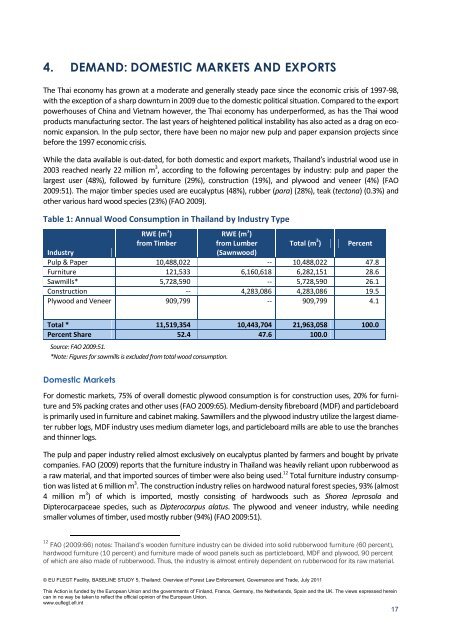BASELINE STUDY 5, Thailand - Forest Trends
BASELINE STUDY 5, Thailand - Forest Trends
BASELINE STUDY 5, Thailand - Forest Trends
You also want an ePaper? Increase the reach of your titles
YUMPU automatically turns print PDFs into web optimized ePapers that Google loves.
4. DEMAND: DOMESTIC MARKETS AND EXPORTS<br />
The Thai economy has grown at a moderate and generally steady pace since the economic crisis of 1997-98,<br />
with the exception of a sharp downturn in 2009 due to the domestic political situation. Compared to the export<br />
powerhouses of China and Vietnam however, the Thai economy has underperformed, as has the Thai wood<br />
products manufacturing sector. The last years of heightened political instability has also acted as a drag on economic<br />
expansion. In the pulp sector, there have been no major new pulp and paper expansion projects since<br />
before the 1997 economic crisis.<br />
While the data available is out-dated, for both domestic and export markets, <strong>Thailand</strong>’s industrial wood use in<br />
2003 reached nearly 22 million m 3 , according to the following percentages by industry: pulp and paper the<br />
largest user (48%), followed by furniture (29%), construction (19%), and plywood and veneer (4%) (FAO<br />
2009:51). The major timber species used are eucalyptus (48%), rubber (para) (28%), teak (tectona) (0.3%) and<br />
other various hard wood species (23%) (FAO 2009).<br />
Table 1: Annual Wood Consumption in <strong>Thailand</strong> by Industry Type<br />
Industry<br />
RWE (m 3 )<br />
from Timber<br />
RWE (m 3 )<br />
from Lumber<br />
(Sawnwood)<br />
© EU FLEGT Facility, <strong>BASELINE</strong> <strong>STUDY</strong> 5, <strong>Thailand</strong>: Overview of <strong>Forest</strong> Law Enforcement, Governance and Trade, July 2011<br />
Total (m 3 ) Percent<br />
Pulp & Paper 10,488,022 -- 10,488,022 47.8<br />
Furniture 121,533 6,160,618 6,282,151 28.6<br />
Sawmills* 5,728,590 -- 5,728,590 26.1<br />
Construction -- 4,283,086 4,283,086 19.5<br />
Plywood and Veneer 909,799 -- 909,799 4.1<br />
Total * 11,519,354 10,443,704 21,963,058 100.0<br />
Percent Share 52.4 47.6 100.0<br />
Source: FAO 2009:51.<br />
*Note: Figures for sawmills is excluded from total wood consumption.<br />
Domestic Markets<br />
For domestic markets, 75% of overall domestic plywood consumption is for construction uses, 20% for furniture<br />
and 5% packing crates and other uses (FAO 2009:65). Medium-density fibreboard (MDF) and particleboard<br />
is primarily used in furniture and cabinet making. Sawmillers and the plywood industry utilize the largest diameter<br />
rubber logs, MDF industry uses medium diameter logs, and particleboard mills are able to use the branches<br />
and thinner logs.<br />
The pulp and paper industry relied almost exclusively on eucalyptus planted by farmers and bought by private<br />
companies. FAO (2009) reports that the furniture industry in <strong>Thailand</strong> was heavily reliant upon rubberwood as<br />
a raw material, and that imported sources of timber were also being used. 12 Total furniture industry consumption<br />
was listed at 6 million m 3 . The construction industry relies on hardwood natural forest species, 93% (almost<br />
4 million m 3 ) of which is imported, mostly consisting of hardwoods such as Shorea leprosola and<br />
Dipterocarpaceae species, such as Dipterocarpus alatus. The plywood and veneer industry, while needing<br />
smaller volumes of timber, used mostly rubber (94%) (FAO 2009:51).<br />
12 FAO (2009:66) notes: <strong>Thailand</strong>’s wooden furniture industry can be divided into solid rubberwood furniture (60 percent),<br />
hardwood furniture (10 percent) and furniture made of wood panels such as particleboard, MDF and plywood, 90 percent<br />
of which are also made of rubberwood. Thus, the industry is almost entirely dependent on rubberwood for its raw material.<br />
This Action is funded by the European Union and the governments of Finland, France, Germany, the Netherlands, Spain and the UK. The views expressed herein<br />
can in no way be taken to reflect the official opinion of the European Union.<br />
www.euflegt.efi.int<br />
17
















